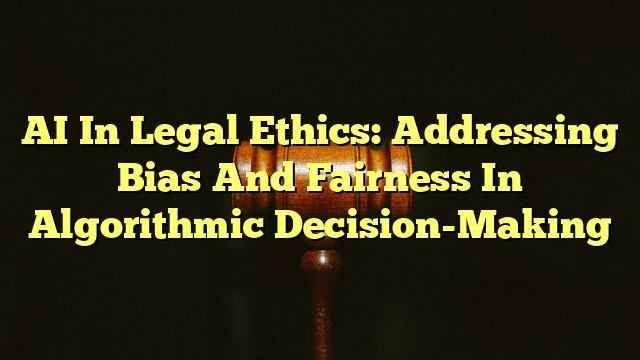Table of Contents
- Introduction
- What is Bias and Fairness in AI Systems?
- What are the Ethical Concerns About Bias in AI?
- What are Some of the Implications of Algorithmic Biases in AI?
- Can AI Improve Fairness and Remove Bias?
- Conclusion
Introduction
Artificial intelligence (AI) is rapidly becoming an integral part of modern society, from healthcare to finance to law. AI algorithms are increasingly being used in legal decision-making, including in the criminal justice system, immigration, and child welfare.
However, AI algorithms can be biased, and biased algorithms can lead to unfair decisions. This has serious ethical implications, as these decisions can have a profound impact on people’s lives. In this article, we will explore the issue of bias and fairness in AI decision-making and how legal ethics can help address this issue.
What is Bias and Fairness in AI Systems?
Bias in AI can be defined as the systematic distortion of a model’s outcomes that affects certain groups of people differently. This can be based on race, gender, age, social class, and other characteristics.
Fairness in AI can be defined as the absence of bias in the algorithm’s decisions. A fair algorithm should make decisions that are unbiased and do not favor any particular group over another.
What are the Ethical Concerns About Bias in AI?
The ethical implications of bias in AI algorithms are significant. Bias in algorithms can lead to unfair decisions that disproportionately affect certain groups of people. This can have a lasting impact on people’s lives, particularly in the criminal justice system, immigration, and child welfare.
For example, biased algorithms can lead to people of color being more likely to be wrongfully convicted, denied visas, or separated from their families. This has serious ethical implications, as these decisions can have a profound impact on people’s lives.
What are Some of the Implications of Algorithmic Biases in AI?
Algorithmic biases can lead to unfair outcomes, which can have serious implications for individuals and society. For example, biased algorithms can lead to people of color being more likely to be wrongfully convicted, denied visas, or separated from their families. This can have a long-term impact on individuals and their families, as well as on communities.
Algorithmic biases can also lead to a lack of trust in AI systems. This can be particularly true for vulnerable groups, who may have a greater distrust of AI algorithms due to their potential for bias. This can lead to a lack of confidence in the fairness of the system and a reluctance to use AI-based decision-making.
Can AI Improve Fairness and Remove Bias?
Yes, AI can help to reduce bias and improve fairness in decision-making. This can be done by using algorithms that are tested for bias before they are deployed, as well as by building AI systems that are more transparent and accountable.
There are also a number of techniques that can be used to reduce bias in AI systems. These include data cleaning, data balancing, and post-hoc debiasing techniques. These techniques can help to reduce bias in AI models and improve fairness in decision-making.
Conclusion
AI algorithms can be biased, and biased algorithms can lead to unfair decisions that disproportionately affect certain groups of people. This has serious ethical implications, as these decisions can have a profound impact on people’s lives. In this article, we explored the issue of bias and fairness in AI decision-making and how legal ethics can help address this issue.
AI algorithms can be designed to reduce bias and improve fairness. Techniques such as data cleaning, data balancing, and post-h


AI brings insight into legal fairness – two-fold challenge: addressing bias & algorithmic decision-making.
Interesting take on legal ethics with AI, but instead of addressing bias and fairness, how about we focus on the accuracy of the decision-making?